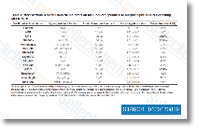Because the late 1980s there are already many smaller trials comparing CMR with endomyocardial biopsy from the diagnosis of heart transplant rejection with predomi nantly favourable final results. In spite of these find ings, CMR hasn’t gained widespread use within the surveillance and diagnosis of acute heart transplant rejec tion. This paper will critique the animal and human data supporting the usage of CMR for your diagnosis of heart transplant rejection and highlight possible CMR targets for long term review. Very best Studied CMR Correlates of Heart Transplant Rejection T2 weighted CMR Myocardial T2 signal intensity Myocardial T2 signal intensity is influenced by myo cardial water articles and may clinically detect myocardial irritation associated with myocarditis, Tako Tsubo cardiomyopathy, and acute myocardial infarc tion. The means of T2 SI to detect heart ezh2 inhibitor transplant rejection continues to be inconsistent while in the literature.
Aherne et al. showed in a canine model that T2 SI was ini tially related involving untreated allografts and non trans plant controls, but by day 7, T2 SI was 66% higher inside the untreated allograft group compared to controls. Wise et al. and Revel et al. identified no variation in T2 weighted SI in patients with biopsy proven rejection com pared to individuals without the need of rejection. Notably, Good et order Sunitinib al. did display that serial signal intensities to get a offered patient elevated with biopsy verified rejection and decreased with anti rejection therapy, having said that the specificity was only 33%. Alemnar et al. located no association in between T2 STIR values and transplant rejection inside a group of forty transplant patients. Despite its utility in other myocardial ailment states, T2 signal intensity has shown mixed results in diagnosing heart transplant rejec tion.
Myocardial T2 Quantification T2 relaxation time is definitely the decay time frequent of magnetic signal  right after an excitatory pulse. T2 rest time is calcu lated by plotting the spin echo signal intensity towards var ying echo occasions and it is believed to lengthen in proportion towards the degree of myocardial edema. Prolonged T2 relaxation instances are associated with higher tissue water con tent in models of myocardial infarction, myocardi tis, and animal designs of acute rejection and is thus a biologically plausible variable to detect human heart transplant rejection. Typical myocardial T2 rest instances fluctuate being a function of magnetic area power and measured values will depend upon whether an suitable pulse sequence for quantifying T2 has been applied. The final stage can’t be stressed ample given that not all T2 weighted pulse sequences are ideal for acquiring correct T2 meas urements. Because of this, CMR research typically define their own regular T2 relaxation instances from a group of controls and describe abnormal T2 relaxation as greater than two common deviations above the imply.
right after an excitatory pulse. T2 rest time is calcu lated by plotting the spin echo signal intensity towards var ying echo occasions and it is believed to lengthen in proportion towards the degree of myocardial edema. Prolonged T2 relaxation instances are associated with higher tissue water con tent in models of myocardial infarction, myocardi tis, and animal designs of acute rejection and is thus a biologically plausible variable to detect human heart transplant rejection. Typical myocardial T2 rest instances fluctuate being a function of magnetic area power and measured values will depend upon whether an suitable pulse sequence for quantifying T2 has been applied. The final stage can’t be stressed ample given that not all T2 weighted pulse sequences are ideal for acquiring correct T2 meas urements. Because of this, CMR research typically define their own regular T2 relaxation instances from a group of controls and describe abnormal T2 relaxation as greater than two common deviations above the imply.
PDGF Signal
PDGF signal transduction inhibition ameliorates experimental
